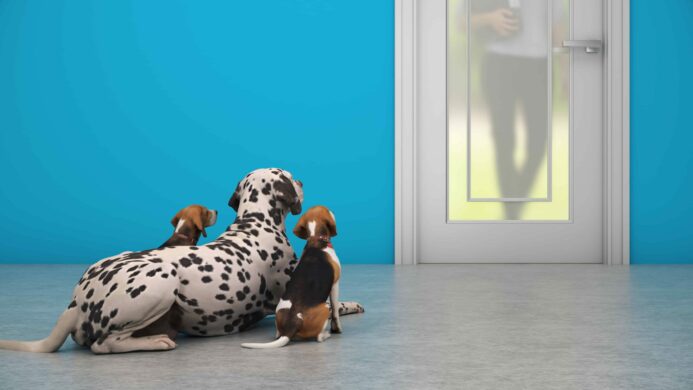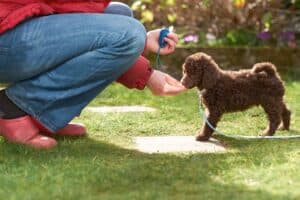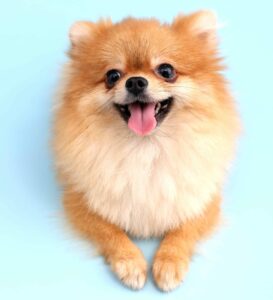
Use impulse control games to teach your dog essential life skills, keep them safe, and curb unwanted behaviors like barking and jumping.
Playing impulse control games with your furry friend helps teach your dog it’s sometimes necessary to wait patiently for something rewarding.
Most games use treats as rewards to encourage your dog to behave. Include those treats in your dog’s daily calorie intake to keep your dog at a healthy weight.
Be consistent and play dog impulse control games daily to improve your dog’s behavior.
Correct problem behaviors
Impulse control games are a dog training tool that can help dogs with problem behaviors, including:
- Sprinting out the front door
- Pulling on the leash
- Running at full speed to greet people or other dogs
- Jumping on strangers
- Putting everything in its mouth
- Impulsively chasing cats, rabbits, or squirrels
- Running into the street.
Why do dogs need to learn impulse control?
Teaching your dog impulse control keeps it safe and eliminates bad behavior, such as jumping on people or sprinting out the door.
Use impulse control games to teach your dog to wait for permission before doing what the dog wants.
You can teach your dog patience with practice, and developing patience sets dogs up for long-term success.
Why do impulse control games work?
Dogs need a bit of help when it comes to impulse control. They don’t understand the concept of delayed gratification (let’s be honest, most humans don’t either). But fun games can help train your dog’s brain.
Without training, dogs will do whatever they want, whether it’s what you wish or not.
First, dogs need a foundation of basic obedience skills like sit, stay, down, and wait. If your dog follows commands to sit or wait, it’ll be less likely to plant paw prints on your neighbor’s new suit or snatch cheese off your dinner plate.
Once your dog masters basic skills, you can use impulse control games to make teaching self-control fun.

15 fun impulse control games to play with your dog
Wait for dinner
Hold the food bowl at hip height or higher, and tell your dog to wait. Slowly lower the bowl an inch or two at a time, rewarding your dog with a piece of kibble for waiting patiently each time. When you put the bowl down, reward them and pick it up again.
Repeat, making your dog wait longer before giving the reward. Next, take a step or two back, then reward your dog. Once your dog has mastered these steps, teach it a release word like OK or go, and then your dog can eat its meal.
Make good choices
You can play two food-based options to improve impulse control.
Hold treats in your hand. Keep your fingers closed so they can smell the treats, but don’t let your dog take them.
Open it slightly when the dog gets bored and stops interacting with your hand. If the dog comes back and sniffs again, quickly close it. Repeat this step until the dog leaves your hand alone.
Once your dog sees the treat and doesn’t try to grab it, reward the dog with the treat.
Continue playing until all the treats are gone.
When your dog masters the game with food in your hand, you can put the food on the floor to increase the difficulty of this self-control exercise.
Place a few pieces of kibble on the floor and cover them with your hand or foot.
When your dog approaches the food, cover it up again. Only let your dog eat the kibble when they wait patiently for your permission.
Learn to be patient
Teach your dog to sit or lie down patiently to earn rewards. Help them understand that they must wait calmly before doing anything fun or rewarding.
That means sitting or lying calmly before walking, playing, or going out the door.
Start by making your dog sit or lie down. Then, make your dog wait for 10, 15, or 20 seconds before doing what it wants. Extend the wait time to 60 seconds.
Your dog will quickly learn that being calm earns the reward.
SMART x 50
If you’re looking for an easy, fun way to help your dog improve impulse control, try the SMART x 50. SMART stands for See, Mark, And Reward, Training.
Start by putting 50 pieces of kibble or treats in an accessible spot like your kitchen counter or dining room table. If your dog is small or struggles with weighing too much, you can reduce the number of treats and make this SMART x 30, 20, or 10.
When your dog does something you like, mark it (say yes or click) and treat them. Repeat throughout the day.
Soon, your dog will make good decisions and behave without you cueing it or giving it directions.
For example, he may learn to lie quietly while you prepare dinner or go into his crate without being asked.
This game is simple and powerful, but it requires observation and consistency. You must watch your dog closely and reward them promptly when you see something you like.
Tug and settle
This game is a perfect activity for high-energy dogs.
Your dog will need to know commands like sit-stay or down-stay, drop it, and a release cue like chill or relax to play.
To get started:
- Play tug with your dog.
- After a few seconds, tell your pup to drop the toy.
- As soon as they do, give the release cue and start again.
Repeat until your dog understands that dropping the toy keeps the game going.
Next, add in the sit or down command. Play tug again and ask your dog to drop it. Then, tell your dog to sit or lie down.
As the dog sits or their elbows hit the ground for down, give the release cue and play again.
To help your dog stay calm, start by asking it to drop the toy. Then, wait for it to sit or lie down without being asked. When it finally lies down, immediately release it and initiate another round.
Increase the time your dog stays down or seated. When your dog is down or sitting after dropping the toy, wait progressively longer before you release it. Start with two or three seconds.
Follow these steps, and your dog will learn to listen for your cues and remain calm in potentially exciting situations.
Leave it
Teaching your dog to “leave it” is a critical skill every pup should know.
This basic command helps your dog resist the urge to grab or eat something they find on the ground.
This skill is essential for dogs who tend to put everything they find in their mouths. It can help prevent them from getting into something dangerous when you’re out on a walk together.
To teach your dog this skill, use this impulse control game. Leash them and toss a treat out of reach. If they start pulling to try and get the treat, stand still until they stop pulling. Then, give them a treat from your hand or pocket.
When your dog masters the basics, you can start complicating things. For example, walk around the treat with your dog on a leash. If the leash stays loose, give your dog a treat.
Have a helper stand out of reach, but don’t let the dog approach that person. Once your dog stops pulling, barking, or trying to interact with your helper, give the dog a treat. Mastering this skill teaches your dog to come to you no matter what, and he’ll get a reward.
Once your dog consistently focuses on you, have your helper move. Again, give them a treat as soon as the dog stops pulling.
Next, have your helper talk or jump or wave his hands. Again, reward your dog if he stays focused despite distractions. This teaches your dog that paying attention to you earns treats.

Unleash calmness
If you want to calm your hyper puppy before walks, try playing this game.
After you hook on the leash:
- Sit on the couch. Stay calm and wait if your dog runs to the door or barks at you.
- Tell your dog to sit or lie down.
- Once your dog settles, tell them yes, OK, or go.
- Walk to the door.
If your dog gets wild again, go back to the couch. Repeat until your dog gets the hint and calmly follows you to the door.
If you’re on a tight schedule, practice on the weekend or when you have more time.
Sit for walks
Train your dog not to run outside by using this impulse control game to teach them to sit calmly when you open it.
Close the door if your dog tries to stand or slip out.
The goal is to show your dog that you only open the door for a walk when it sits calmly. Once it does, reward your dog with a treat, and then go for your walk.
With time and repetition, your dog will learn to sit calmly at the door and await your invitation before walking.
Take chill walks
Teach your dog to walk on a leash like a pro. With patience and plenty of treats, your pup will stick by your side in no time.
Remember to reward good behavior – if the leash is slack and your dog behaves calmly, give them a treat.
If your dog starts to pull, slow down or even stop. Once the dog settles down, you can resume walking and give them another treat.
Keep in mind that the first few walks might take a while.
Be consistent with your commands and rewards, and your dog will quickly learn that walking with a loose leash means more attention and uninterrupted walks.
Remember that treats aren’t the only reward — the walk itself is a treat, as is letting your dog take a few minutes to sniff.
When meeting other dogs or people, be cautious and put your dog in the down position. Make sure everyone is safe before you introduce them. Never let your dog jump on other people or dogs.
Sit when meeting new people
When you meet someone, make your dog sit or be in a down position. Make your dog sit before petting. In theory, sitting will stop jumping since your dog can’t do both simultaneously.
Start by sitting in a circle with friends, family, or neighbors. Have people take turns calling the dog. Make them sit before petting them. You can also give your dog a treat to thank them for cooperating.
Next, make your dog sit when guests arrive. Reinforce good behavior with praise, pets, and a tasty treat.
Take treats with you on walks, and make your dog sit when you meet someone new on walks.
Sit for car rides
If your dog gets excited before going on a car ride, make them sit before you open the car door.
Put your dog in a sit or down before you open the car door. If your dog stays calm, give it the cue to hop in. You can use something like “hop up” or “get in” and let the dog get in the car.
If your dog is nervous about car rides, you must reduce his fear first.
Ignore dropped food
If your dog tries to eat someone else’s food or steal it from the table or counter, or if it tries to eat any food you drop, you must teach it to “leave it.”
Start by putting food on the floor. Cover it with your foot and tell your dog to “leave it.” If your dog ignores the food or doesn’t paw at your foot, reward them.
Repeat until your dog ignores the food.
Train your dog to ignore table scraps. Put a treat in your pocket and hold a piece of bread in your hand. Hold the hand with the food out to your dog. If the dog tries to take the bread, say “leave it” and close your hand.
When your dog drops its nose from your hand, say, “yes,” and give it the treat. Repeat several times.
Continue until your dog ignores the bread in your open hand. Most dogs learn quickly to ignore the food to get a better treat.
Make the game more challenging by putting the food on the floor or a surface your dog can reach.
Give treats that are more appealing than training food. That will teach your dog that what you offer is always better.
Structured fetch game
Playing games like fetch can amp up an already hyper dog.
But an impulse control game like structured fetch teaches your dog to sit calmly even when he wants to run, bark, jump, or spin in circles.
It’ll take time for your dog to understand he only gets the ball or frisbee if he sits and doesn’t bark.
To make it more difficult, make your dog wait after you throw the ball. Then tell them to go or say, “Get it.”
Help your dog master zen
Try this game to help your dog relax and control impulses to engage in other behaviors.
To give your dog the best chance at success, do this after he exercises and gets some mental stimulation.
Sit on the couch with your dog on a leash, holding it firmly under your foot. Allow enough slack so your dog can sit, stand up, and lie comfortably. Watch your favorite TV show or read a book or magazine while your dog relaxes nearby.
Ignoring your dog’s bad behavior is essential, no matter how tempting it is to give in.
If he’s barking, chewing on the leash, or pulling you around, wait it out.
Eventually, he’ll settle down, and you can praise them and give them a treat.
With enough practice, your dog will learn to lie down and chill on cue.

Be quiet (stop barking)
If your dog gets excited when he sees people, dogs, or cars through the window, this simple game can help them learn impulse control.
First, make a kissing sound with your mouth, then hold a treat at eye level.
Give your dog the treat as soon as he looks at you. Repeat 10-15 times until your dog understands the association between the kissing sound and receiving a treat.
Once your dog grasps the concept, try doing it from across the room.
If your dog drops everything and comes running toward you when he hears the kissing sound, you know he’s getting the hang of it.
When your dog sees something outside the window, practice this exercise. Start with less intense triggers, like a family member or friend walking back and forth. Then, toss the treat away from the window.
If your dog doesn’t respond or take the treat, he’s overstimulated. Take a step back and try again with less intense triggers.
If you can’t actively supervise, keep your dog away from windows, or he’ll return to his old behavior.
Put them in a room without windows, or draw the curtains or blinds so he doesn’t need to react. You can also create a buffer using white noise or music.
Address challenges
Troubleshooting tips
When implementing impulse control games, addressing any potential issues that may arise is essential.
Here are some troubleshooting tips to help you successfully implement these games:
Clear instructions: Ensure that the instructions for the impulse control games are clear and easy to understand. Confusion about how to play the games can lead to frustration and disengagement.
Patience and persistence: Encourage patience when participants struggle with the games. Impulse control takes time to develop, so fostering a supportive and understanding environment is essential.
Tailored support: Provide individualized support for participants who may find the games particularly challenging. Tailoring the difficulty level to each individual’s abilities can help ensure a positive experience.
Addressing frustration: Provide coping strategies to help participants manage their frustration. Encouraging deep breathing or taking a short break can help prevent frustration from escalating.
Evaluating progress: Continuously assess your dog’s progress and adjust as needed. Celebrate small victories and provide constructive feedback to support ongoing improvement.
Final thoughts on playing impulse games
If you’ve been consistent with playing impulse control games with your dog, you should start to see some improvements in their behavior.
Use treats as rewards judiciously so your dog doesn’t gain too much weight.
You can have a well-behaved dog in no time with patience and effort.
 Sara B. Hansen has spent 20-plus years as a professional editor and writer. She’s also the author of The Complete Guide to Cocker Spaniels. She decided to create her dream job by launching DogsBestLife.com in 2011. Sara grew up with family dogs, and since she bought her first house, she’s had a furry companion or two to help make it a home. She shares her heart and home with Nutmeg, a Pembroke Welsh Corgi. Her previous dogs: Sydney (September 2008-April 2020), Finley (November 1993-January 2008), and Browning (May 1993-November 2007). You can reach Sara @ editor@dogsbestlife.com.
Sara B. Hansen has spent 20-plus years as a professional editor and writer. She’s also the author of The Complete Guide to Cocker Spaniels. She decided to create her dream job by launching DogsBestLife.com in 2011. Sara grew up with family dogs, and since she bought her first house, she’s had a furry companion or two to help make it a home. She shares her heart and home with Nutmeg, a Pembroke Welsh Corgi. Her previous dogs: Sydney (September 2008-April 2020), Finley (November 1993-January 2008), and Browning (May 1993-November 2007). You can reach Sara @ editor@dogsbestlife.com.
